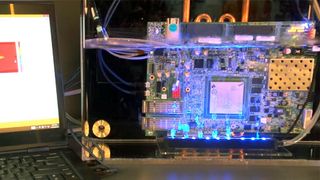Overclockers first explored liquid immersion cooling in the early 2000s, and select makers of servers adopted it for datacenters. Now, Bitcoin miners are turning to immersion cooling systems as they promise to eliminate overheating of cryptocurrency mining machines and maximize their earnings.

"The immersed equipment runs faster without overheating," said Nishant Sharma, founder of mining consultant BlocksBridge, in an interview with Bloomberg. "It looks like a fish tank with machines inside it. Sooner or later, all big miners will be doing large-scale immersion mining."
For example, Riot Blockchain, a Nasdaq-listed cryptocurrency miner from Texas, recently announced plans to develop the industry's first large-scale immersion-cooled Bitcoin mining facility with 46,000 mining machines. The facility will consume a whopping 20 MegaWatts of power. Meanwhile, some miners used liquid immersion cooling back in 2018.
Large Bitcoin mining farms resemble datacenters. Both use loads of expensive machines that crunch numbers 24/7 (only datacenters process useful data); both need to cool these machines down; both strive to maximize compute density; and both often have space constraints.
However, there are several significant differences. Datacenters are located in special facilities designed with air or liquid cooling in mind (two methods that require large cooling equipment). By contrast, mining farms are located in abandoned industrial facilities or warehouses. Operators of datacenters are concerned about things like total cost of ownership (TCO), so they tend to choose technologies that offer the right combination of features and qualities to keep their TCO in check. By contrast, since 80% of a miner's operating costs are electricity bills, cryptocurrency miners are concerned chiefly about performance and stable power supply rather than about TCO.
These days numerous cryptocurrency farms employ immersion cooling systems to lower temperatures of their mining machines, maximize their performance, and increase earnings per machine (which are quite expensive). Immersion cooling cools all components of a system and does not require large and complex equipment like industrial air conditioners or liquid cooling systems. However, this does not mean that immersion cooling is easy (or cheap) to deploy or service. Meanwhile, usage of immersion cooling allows the installation of additional mining machines into the same building to maximize their performance, two factors that offset all possible downsides of this method for cryptominers.
Immersion cooling has existed and evolved for years, so there are loads of equipment and non-conductive liquids to choose from, depending on whether one is dealing with a single-phase or dual-phase method of immersion cooling. Therefore, miners will not have technological problems deploying immersion cooling systems. What remains to be seen is how the volatility of cryptocurrencies affects cryptomining companies' willingness to enormous amounts of money into hardware while ignoring common practices set by traditional datacenters.





